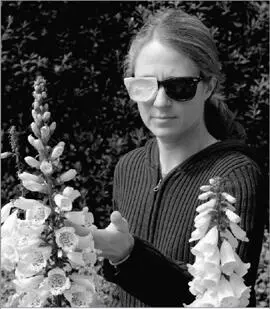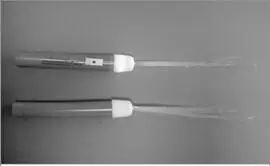Exercise Program for Retinal Detachment
• Look at Details (with the parts of your eyes that are not functioning well, by covering the parts that do see well): 10 minutes daily.
• Look into the Distance: 20 minutes daily, in 10-minute intervals.
• Palming: 24 minutes daily, 6 minutes at a time (once a week, as long as you do not have glaucoma, sit down and palm for an hour, listening to something pleasant like music or a book on tape).
• Darkness and Light Exercise: 20 minutes daily.
With retinal detachment, after exercising the blind or fuzzy spot, quite a few people start to have some more vision in it, which is a wonderful phenomenon. It happens because some of the cells are only dormant, even though some are dead. When we wake up the dormant cells, we have access to more vision.

Figure 6.9. Look at details with the parts of your eyes that are not functioning well.
Extra Exercise for Retinal Detachment: Darkness and Light
If parts of your retina are dead, or if you have a sighted eye, patch your sighted eye and with paper obstruct the parts of your disabled eye that are still functioning. Then look at the world through holes in the paper, using only the parts of your eyes that do not function well.
Four times a day, after six minutes of palming, go into a dark room. Now you will want to use blinking lights. At the School for Self-Healing we sell small blinking lights you can use for this exercise, but any different-colored blinking lights will do. The object is simply to turn on the blinking lights to activate the parts of your eyes that are not working.

Figure 6.10. Use blinking or flashing lights in a dark room to activate the parts of the eyes that are not working.
When you have the functional parts of your eyes covered and you are looking at blinking lights in a dark room, you may not see anything at all at first. But over time you may start to see small changes in the darkness. Small flashes of light may start to occur. Be patient. In time you may start to see more and more flashing lights and, eventually, shapes may start to occur. Sometimes a picture comes; when it does, it’s wonderful!

Figure 6.11. The small blinking lights we use at the school.
A much more subtle way of accomplishing this same exercise is to obstruct the functional part of your eyes and to walk outside in bright sunlight, crossing between a brightly lit area and a shaded area. Walk with somebody who can help you to make sure you do not trip. Move your head from side to side, but do not move your eyes. The extremes of light and dark may start to become apparent over time. In this way, you are accomplishing the same thing as with the blinking lights. You are activating the part of your eyes that does not function well, so that vision in your blind spot will start to develop.

Figure 6.12. Our magic wands.
If you have some vision, obstruct your strong eye with a patch and your weak eye with paper with holes cut out for the weak areas to look through. Now walk in your garden or somewhere safe, with a companion who can hold your hand or catch you if you fall, and move your head from side to side slowly so as to help you notice more details. Then take off your patches; 75 percent of people who do this will see an immediate improvement in their vision. The improvement is temporary, but repetition of this exercise makes it become stable.
Correcting Vitreous Detachment
The vitreous is the gel-like substance that covers the surface of the retina, and it is in fact attached to the retina via millions of fine, intertwined fibers. As the vitreous shrinks from age and neglect, detachment from the retina can occur.
Vitreous detachment is much more common, but less harmful, than retinal detachment. Only in rare cases does vitreous detachment lead to partial blindness. But it does lead to a tremendous amount of floaters that obstruct vision. A floater is a tiny dark spot that seems to be floating around in your field of vision, obstructing what you are looking at.
In a minority of cases, vitreous detachment can lead to retinal detachment or puckers, by pulling apart the retina; this, in turn, can lead to bleeding and flooding of the photoreceptor cells, causing blindness. But most of the time, it’s relatively harmless and just leads to some floaters.
Normally, with a retinal pucker, after looking at an eye chart and seeing it to some extent, there is a sense of clarity in the rest of your visual system. If you take off the pinholes and you take off the patch, you will find that your vision is very much clearer. That’s why repetition of these exercises is so useful.
If you experience vitreous detachment, however, I recommend getting checked by two or three ophthalmologists, especially retinal specialists, to be sure that the detachment didn’t cause any harm to the retina at the same time.
Often, people are afraid of the floaters. A good way to deal with them might seem rather amazing and surprising. The secret is to look at them! You just walk outdoors on a very sunny day, or at least on a bright day, and look at the floaters one by one. If you cannot see them one by one because there are groups of floaters, look at them group by group. When you isolate and look at the floaters, you cause the vitreous fluid to collide against the floaters, which breaks them up and causes them to disappear.
For example, if you have more floaters in your right eye, patch or obstruct your left eye and walk for twenty minutes in the sun, somewhere with a nice view to look at. As you look at the view, floaters will appear. As they appear, look right at the floaters; as you do, the vitreous fluid will collide against them and destroy them. Normally, what happens when you look at a floater is that it floats away and then comes back; when you look at it again, your vitreous fluid hits the floater and breaks it into pieces. Then you see smaller pieces, and you look at either one of them or at several pieces, and you break them once again.
Choose a floater to look at, possibly the largest one, and when it floats away, look into the distance. Then look at that floater again when it comes back, and exercise with that floater, back and forth, every day. Most likely, after a few weeks, that floater will disappear. Then you choose the next one. Do it in a neutral state of mind; blink and breathe. If you have floaters in both eyes, but more in one eye than the other, patch the eye with fewer floaters and look at the floaters with the other eye.
I had a patient named Tony who had laser surgeries, retinal detachment, and terrible vitreous floaters. Moreover, he couldn’t drive. His doctor had mistakenly told him to wear sunglasses. That only made the floaters worse. I told him to do a lot of sunning, to walk, and to look at the floaters. I will never forget the time I walked with him up and down a hill around my previous office. He looked at plants, he looked at the view, and very quickly he improved his vision from 20/200 with glasses to 20/20 with glasses; he also reduced his diopter level significantly, from 13 to 8 diopters.
Читать дальше















